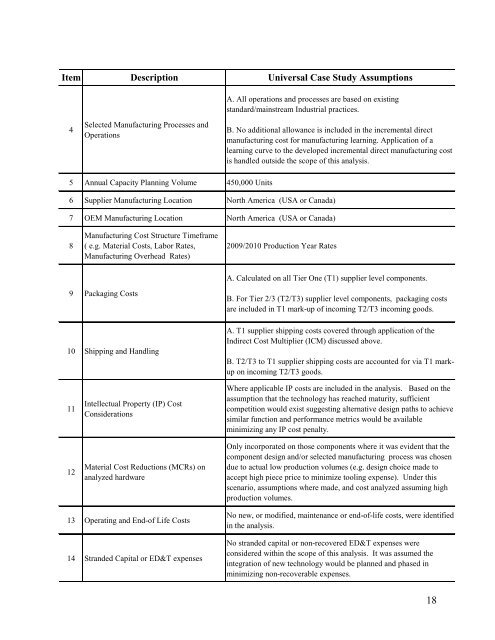Light Duty Technology Cost Analysis, Power - US Environmental ...
Light Duty Technology Cost Analysis, Power - US Environmental ...
Light Duty Technology Cost Analysis, Power - US Environmental ...
Create successful ePaper yourself
Turn your PDF publications into a flip-book with our unique Google optimized e-Paper software.
Item Description Universal Case Study Assumptions<br />
4<br />
Selected Manufacturing Processes and<br />
Operations<br />
5 Annual Capacity Planning Volume 450,000 Units<br />
A. All operations and processes are based on existing<br />
standard/mainstream Industrial practices.<br />
6 Supplier Manufacturing Location North America (<strong>US</strong>A or Canada)<br />
7 OEM Manufacturing Location North America (<strong>US</strong>A or Canada)<br />
8<br />
Manufacturing <strong>Cost</strong> Structure Timeframe<br />
( e.g. Material <strong>Cost</strong>s, Labor Rates,<br />
Manufacturing Overhead Rates)<br />
9 Packaging <strong>Cost</strong>s<br />
10 Shipping and Handling<br />
11<br />
12<br />
Intellectual Property (IP) <strong>Cost</strong><br />
Considerations<br />
Material <strong>Cost</strong> Reductions (MCRs) on<br />
analyzed hardware<br />
13 Operating and End-of Life <strong>Cost</strong>s<br />
14 Stranded Capital or ED&T expenses<br />
B. No additional allowance is included in the incremental direct<br />
manufacturing cost for manufacturing learning. Application of a<br />
learning curve to the developed incremental direct manufacturing cost<br />
is handled outside the scope of this analysis.<br />
2009/2010 Production Year Rates<br />
A. Calculated on all Tier One (T1) supplier level components.<br />
B. For Tier 2/3 (T2/T3) supplier level components, packaging costs<br />
are included in T1 mark-up of incoming T2/T3 incoming goods.<br />
A. T1 supplier shipping costs covered through application of the<br />
Indirect <strong>Cost</strong> Multiplier (ICM) discussed above.<br />
B. T2/T3 to T1 supplier shipping costs are accounted for via T1 markup<br />
on incoming T2/T3 goods.<br />
Where applicable IP costs are included in the analysis. Based on the<br />
assumption that the technology has reached maturity, sufficient<br />
competition would exist suggesting alternative design paths to achieve<br />
similar function and performance metrics would be available<br />
minimizing any IP cost penalty.<br />
Only incorporated on those components where it was evident that the<br />
component design and/or selected manufacturing process was chosen<br />
due to actual low production volumes (e.g. design choice made to<br />
accept high piece price to minimize tooling expense). Under this<br />
scenario, assumptions where made, and cost analyzed assuming high<br />
production volumes.<br />
No new, or modified, maintenance or end-of-life costs, were identified<br />
in the analysis.<br />
No stranded capital or non-recovered ED&T expenses were<br />
considered within the scope of this analysis. It was assumed the<br />
integration of new technology would be planned and phased in<br />
minimizing non-recoverable expenses.<br />
18

















